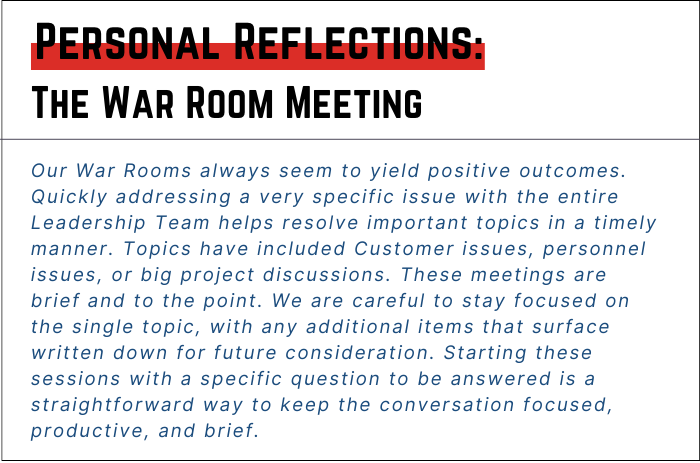Even with a solid and regular system of your Operations meetings, are there some topics that don’t seem to fall within any of those meetings? Do you sometimes need special gatherings to deal with specific issues? If either situation sounds familiar, then we’ve got a few additional meetings for you to consider as you run your company’s Operations.
In this Series, we’re reviewing the 6-Step Plan to run your business from Donald Miller’s latest book, How to Grow Your Small Business, and the online platform at businessmadesimple.com.
The analogy of an airplane helps describe the 6 Steps needed to run your business effectively and this week, we’re continuing with our final installment in Step 5, the Body, Your Overhead & Operations.
In this part of Step 5, Don introduces three additional meetings in the Management & Productivity Made Simple Playbook:
- The Monthly Revenue Meeting
- The War Room
- The Leadership Catch-All
These meetings each have a few guidelines that will help you to maximize their benefit.
The Monthly Revenue Meeting
Because revenue is the lifeblood of every business, it makes sense to evaluate revenue results and near-term revenue projections on a monthly basis. The financial member of the Leadership Team should prepare the numbers for this meeting, and it is typically held with the entire Leadership Team. The Monthly Revenue Meeting is focused on the following:
- Last Month Revenue Review
- How much money did the company make last month?
- Discuss why the company did or did not succeed in meeting expectations.
- Next Month Revenue Projection
- What is the projected revenue for the coming month?
- Discuss how to improve upon that number.
- Last Month Revenue Review
It’s likely that this review of revenue will provide some action items for different members of the Leadership Team that may adjust some of their Personal Priorities or their Department Priorities. The overall priorities of the business are often related to revenue drivers, so the actions identified in the Monthly Revenue Meeting will help improve the results of those priorities.
The War Room Meeting
Sometimes, you and your Team need to gain fast ground on a project. Calling a War Room Meeting can gather a select group of people to address a time-sensitive issue. A War Room is not a catch-all meeting. It is a focused session to deal with a particular issue that needs to be addressed immediately. Examples include:
- Evaluating a new building for the business.
- Reviewing a particular project or Customer that has an emerging issue.
- Addressing a potential new hire or needed role on the Team.
Starting the War Room with a specific issue to be resolved or question to be answered helps maintain focus and helps signal to the participants when the objective has been achieved.

The Leadership Catch-All Meeting
As you interact with your Leadership Team using the Management & Productivity Made Simple Playbook, you’ll get into a productive rhythm that is focused on the overall priorities of the business and topics that flow from those activities. Outside of that scope, there are other topics that may never reach the level of impacting the overall business priorities, but still need to be addressed by the Leadership Team.
Having a Leadership Catch-All Meeting is one way to discuss additional business topics without sidetracking the productive rhythms of your normal meeting schedule. These Leadership Catch-All Meetings should be held infrequently, and the Leadership Team can submit topics of conversation ahead of time to ensure that they aren’t simply open-ended and unfocused sessions. Once again, having a specific question or issue that needs to be resolved will help keep the meeting focused and productive.
Final Thoughts
Step 5 from Donald Miller’s book, How to Grow Your Small Business, is the Body – Your Overhead & Operations. In Step 5, we’ve discussed the Management & Productivity Made Simple Playbook, a process to run your business using 5 meetings:
- The All-Staff Meeting
- The Leadership Team Meeting
- The Department Stand-Up Meeting
- The Personal Priority Speed Check
- The Quarterly Performance Review
These meetings can become part of your routine structure so that your business can scale without you having to manage your entire Team on your own. The Management & Productivity Made Simple Playbook meeting structure provides the format so your Leadership Team and Department Leaders can keep everyone working on the overall business priorities, as well as the resulting priorities for each of the departments and every Teammate.
This week, we added 3 additional meetings that fall outside of the regular meeting cadence:
- The Monthly Revenue Meeting
- The War Room Meeting
- The Leadership Catch-All Meeting
Utilizing these meetings, and everything we’ve discussed in Step 5, will ensure the Body of your small business airplane, your Overhead & Operations, can be managed effectively so that it won’t limit the altitude you can achieve. The biggest part of your Overhead is the people on your airplane, and those people are one of the biggest reasons you have a plane in the first place. You want your business to be able to fly them far and high, soaring to new heights of success.
Next week, we’ll move onto the final step of the airplane analogy from How to Grow Your Small Business, Step 6, The Fuel Tanks (Cash Flow). We’ll start to discuss the 5 checking accounts you’ll need to run your small business to ensure you never run out of fuel.


